Welcome back to Magic Gatherings!
I hope everyone had a great time at the Oath of the Gatewatch prerelease last weekend! I had a chance to play in the Sunday evening Two-Headed Giant event at Pandemonium in Cambridge, which was a blast (and very successful). More on that in a bit, though.
Last week was my customary limited set review, and this week I’m continuing a new tradition by talking about limited archetypes for Oath of the Gatewatch draft. As a reminder, archetypes are draft strategies. More specifically, for our purposes, they’re card lists of idealized or representative draft decks. Archetypes give you a roadmap for your draft pics and help you make decisions about what cards to prioritize and what cards to cut. In the abstract, they can also work as proof-of-concept for deck ideas that you think could work, but haven’t been able to try yet.
Generally speaking, a well-planned archetype helps you draft and build a more powerful limited deck. When it comes to Oath of the Gatewatch, archetypes are in a funny place: the conventional wisdom from Magic pros is that Oath is a set where picking generically powerful cards is better than drafting synergistic decks that are more than the sum of their parts. What to do with archetypes in Oath, then? First, let’s take a moment to consider the power that comes from building a limited deck according to a particular plan.
SO, ABOUT THOSE POWERFUL LIMITED DECKS…
A short digression for #sickbrags. My friend Stephen and I hit the lotto at the prerelease (the Magic lotto, not the $1.5 Billion lotto) and built two great decks, which we piloted to a 3-0-1 record. We were very fortunate with our pool, which furnished lots of powerful cards, most of which we were able to play.
First, my deck, which was an excellent green-black tokens deck:

This deck had one plan: put a bunch of creatures on the table, pump them up, and swing for huge chunks of damage. Six creatures make Eldrazi Scion tokens (several make two at once), and there are five effects to boost them: Nissa, Drana, [mtg_card]Gladehart Cavalry[/mtg_card], [mtg_card]Swarm Surge[/mtg_card], and [mtg_card]Stoneforge Masterwork[/mtg_card] (which made every creature into a 6+ power must-kill threat).
To zone-block for the scion swarms, we made up a blue-red surge control deck for my teammate:

Stephen had three [mtg_card]Boulder Salvo[/mtg_card], two [mtg_card]Sweep Away[/mtg_card], three [mtg_card]Abstruse Interference[/mtg_card], and a host of other cards that kept our opponents from mustering defenses. I was able to poke in for damage for the first few turns while our opponents set up, then (after Stephen bounced or boulder’d our opponents’ best blockers), I would crack in with a [mtg_card]Swarm Surge[/mtg_card] or a Masterwork-equipped [mtg_card]Sky Scourer[/mtg_card]; our opponents would have to chump block or take loads of damage, and either way they were usually too far behind to recover. In one game, Stephen shut down every opposing blocker with [mtg_card]Immobilizer Eldrazi[/mtg_card], which freed me up to use Nissa to put +1/+1 counters on all six of my creatures, cast [mtg_card]Swarm Surge[/mtg_card], and swing for 27 damage.
My team’s great decks (and my desire to gloat) aside, there’s a larger point here: part of what made these decks so strong is that we understood what each deck was trying to accomplish and cut anything extraneous. I made the first pass on the blue-red surge deck, then passed it to Stephen, who promptly cut a bunch of reasonable-but-off-plan cards like [mtg_card]Goblin Freerunner[/mtg_card] and [mtg_card]Wave-Wing Elemental[/mtg_card]. Meanwhile, my deck had almost no creatures that weren’t Eldrazi and only one removal spell, since I knew Stephen had me covered. We left lots of good cards in the sideboard, but each deck had the tools it needed to accomplish its plan.
Which brings us back to the topic at hand: archetypes. When you’ve mapped out the plan for your limited deck, it means you’ve put in the thought to understand what the deck is trying to do, so you can select the best cards for the job. The result is a cohesive whole: much better than a random pile of good cards.
From Synergy to Goodstuff
Generally speaking, I think the conventional wisdom about Oath of the Gatewatch draft is true: good decks in Oath limited seem more likely to be collections of cards that are each individually powerful or efficient, as opposed to the sleek, synergistic decks of Battle for Zendikar. To understand why, we can consider BFZ‘s mechanics, which often formed the basis for its limited decks. Since we’ll now be drafting Oath-Oath-BFZ, we should think about how those mechanics will fare with two fewer BFZ packs in the format:
- Awaken: The backbone of many a powerful white-blue tempo deck, awaken was a great way to spend extra mana in the late game to add additional threats to the board (and, usually, neutralize a threat at the same time). Oath has ways to generate land creatures ([mtg_card]Cyclone Sire[/mtg_card], [mtg_card]Wall of Resurgence[/mtg_card], and the red-green landfall lords), but only at uncommon. Meanwhile, blue’s bounce spell in this set, [mtg_card]Sweep Away[/mtg_card], costs three mana, whereas cheap tempo answers like [mtg_card]Containment Membrane[/mtg_card] are their own card, and require additional setup. Former all-stars like [mtg_card]Halimar Tidecaller[/mtg_card] really suffer when you only have a few shots to pick up [mtg_card]awaken[/mtg_card] spells.
- Converge: Converge was already in a rough place in Battle for Zendikar, as it lacked reliable payoffs at
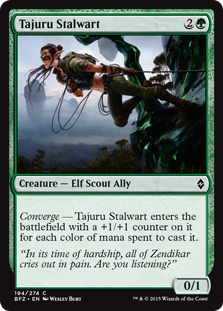 common; the best was [mtg_card]Tajuru Stalwart[/mtg_card], but her 3/4 body wasn’t sized well for BFZ, where huge Eldrazi ruled the battlefield. Stalwart is better positioned now, but you may have a tough time finding enough converge enablers, as other drafters need them to fix colorless mana.
common; the best was [mtg_card]Tajuru Stalwart[/mtg_card], but her 3/4 body wasn’t sized well for BFZ, where huge Eldrazi ruled the battlefield. Stalwart is better positioned now, but you may have a tough time finding enough converge enablers, as other drafters need them to fix colorless mana. - Devoid: There are still plenty of colorless Edrazi running around, but two fewer packs of BFZ mean fewer shots at cards like [mtg_card]Nettle Drone[/mtg_card] and [mtg_card]Vile Aggregate[/mtg_card], which really rewarded you for playing an all-devoid deck. Meanwhile, many common and uncommon Eldrazi creatures have abilities that can only be activated with colorless mana. That puts extra pressure on your picks in Oath, where you need to make sure to draft [mtg_card]Wastes[/mtg_card] and the like.
- Rally: There will actually be, on average, a few more Allies in Oath draft, so you can expect to trigger the rally effects you do draft. Like devoid, though, you have fewer opportunities to get the best rally creatures. On the other hand, because creature sizes look to be tightening up a bit with Oath, the rally triggers from your BFZ cards (which usually granted combat-relevant abilities like first strike and trample) will probably matter more: vigilance is especially good, since Oath gives your Ally decks cohort. Watch for those [mtg_card]Makindi Patrol[/mtg_card]s!
- Landfall: This is an archetype that required density of effect to be powerful. You wanted all of your creatures to have landfall, since making all your creatures better than your opponent’s creatures created mismatches that helped your attackers get through.
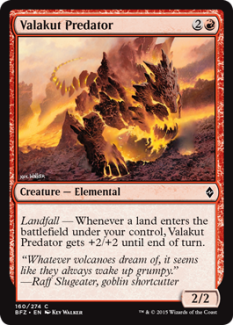 Oath has only two landfall creatures, and they’re both uncommon(albeit very powerful). Landfall creatures now need to be evaluated on their stats; [mtg_card]Valakut Predator[/mtg_card] and [mtg_card]Ondu Greathorn[/mtg_card] probably get better, since they can punch through x/4 blockers, but [mtg_card]Snapping Gnarlid[/mtg_card] probably gets worse.
Oath has only two landfall creatures, and they’re both uncommon(albeit very powerful). Landfall creatures now need to be evaluated on their stats; [mtg_card]Valakut Predator[/mtg_card] and [mtg_card]Ondu Greathorn[/mtg_card] probably get better, since they can punch through x/4 blockers, but [mtg_card]Snapping Gnarlid[/mtg_card] probably gets worse. - Ingest/Process: The list of ways to exile is very short, and only a couple are repeatable; none are what I’d call “reliable.” In addition Oath has no creatures that process exiled cards. I think these decks are dead; except for rare circumstances, it’s too much to ask that you pick up your best enablers and your best payoff cards all in the third pack.
- One important final note, which I mentioned last week, is that the Eldrazi don’t curve as high in Oath of the Gatewatch. Whereas BFZ had [mtg_card]Ruin Processor[/mtg_card] and [mtg_card]Eldrazi Devastator[/mtg_card] at common and a whole bunch of game-breaking uncommon fatties, Oath has [mtg_card]Kozilek’s Pathfinder[/mtg_card]—and that’s it. Creature powers and toughnesses fall into a more narrow band, which means creature combat should matter more, and mid-size bodies (3/4, 4/3, etc.) should be better sized.
The common theme is pretty clear: many Battle for Zendikar draft decks were built around a single mechanic or an overarching synergy, and losing two BFZ packs really hurts those decks. With less synergy to draft around, taking the “best” card will be the right call much more often.
Even in draft formats like that, though, it’s important to have a good understanding of what your final deck can and should look like. If there is any profitable synergy to be found, this is a good way to find it. If not, you can at least come to a better understanding of what the schematic strengths and weaknesses of your deck are—the kinds of cards that can give your deck problems, or your best cards and the best ways to support or protect them. Archetypes can also help forestall structural issues. For example, in Oath of the Gatewatch, several colors are especially flush with four- and five-mana cards. Having a good idea of where your deck is going will help you understand when a particular card is a great fit for your deck, versus when it’s just a filler card that could be replaced by virtually any other creature in the format.
Oath Archetypes
So, looking ahead to the possible archetypes in Oath draft, what do we see? Here’s my preliminary thoughts on every color pair, with sample archetypes sprinked in liberally. If you’d like a second opinion on any of these, check out Modern Masters champion Neal Oliver’s views on green-white and white-blue here. (He should be updating that series in the days to come.)
Note that when you make your own archetypes, you should remember to balance the sets correctly: on average, you’ll have 15–16 Oath cards and 7–8 BFZ cards in each of your draft decks.
- Green-White:
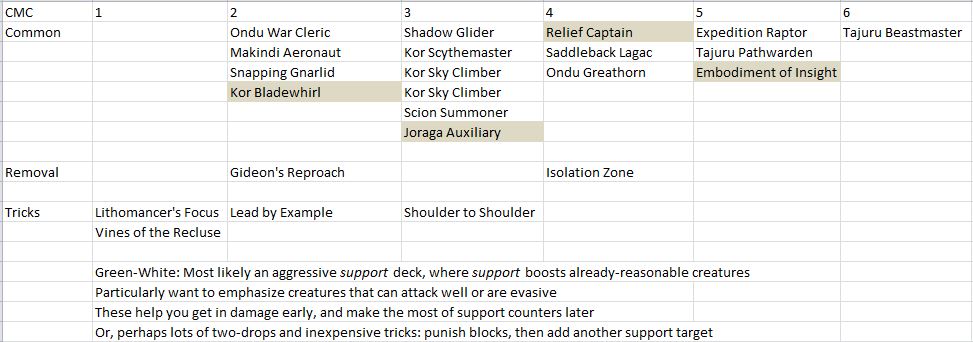
Support should be good in most white decks, but it can be especially effective in an aggressive green-white shell.
[See the deck on TappedOut here to see card images and such.] In discussing the support mechanic last week, I speculated that it would be at its best capping off the curve of an aggressive deck. This seems like one of the best fits, since green and white both get access to support. The trick will be the two-drops. Support rewards creatures that are evasive and attack well, since trading your creature for an opponent’s takes a potential support target off the board. (Evasive creatures are better value after you support them, as well.) Unfortunately, green and white aren’t flush with tough-to-block low-curve creatures, especially at common. I like [mtg_card]Snapping Gnarlid[/mtg_card] and I love [mtg_card]Kor Bladewhirl[/mtg_card], but cards like [mtg_card]Ondu War Cleric[/mtg_card] and [mtg_card]Oran-Rief Invoker[/mtg_card] are likely to die in combat or sit tight until you make them big enough to attack safely. [mtg_card]Stalking Drone[/mtg_card] and [mtg_card]Makindi Aeronaut[/mtg_card] could work, but both require some help to be optimal. The three-drops look great, though, and I especially like Shadow Glider.
- White-Blue: As I mentioned above, losing two packs of powerful awaken cards is pretty big deal for this pair.
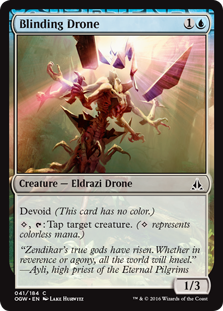 They still have flyers, though slightly more anemic ones than BFZ had—there’s nothing that gets over 3 power like [mtg_card]Angel of Renewal[/mtg_card] or [mtg_card]Wave-Wing Elemental[/mtg_card]. Since their flyers tend toward the defensive, white-blue should also be able to field a more traditional control deck, perhaps stalling until something like [mtg_card]Roiling Waters[/mtg_card] comes online.
They still have flyers, though slightly more anemic ones than BFZ had—there’s nothing that gets over 3 power like [mtg_card]Angel of Renewal[/mtg_card] or [mtg_card]Wave-Wing Elemental[/mtg_card]. Since their flyers tend toward the defensive, white-blue should also be able to field a more traditional control deck, perhaps stalling until something like [mtg_card]Roiling Waters[/mtg_card] comes online. - Blue-Black: Two fewer BFZ packs hits blue-black even harder than blue-white, as I mentioned above; it’s very hard to field the ingest plan blue-black had in BFZ. Thanks to [mtg_card]Kozilek’s Translator[/mtg_card] and [mtg_card]Cultivator Drone[/mtg_card], this deck might still be able to use the truly large Eldrazi from BFZ, defending itself with [mtg_card]Blinding Drone[/mtg_card] and [mtg_card]Vampire Envoy[/mtg_card] until [mtg_card]Eldrazi Devastator[/mtg_card] comes online.
- Black-Red: They still have devoid creatures, and while I love [mtg_card]Maw of Kozilek[/mtg_card], [mtg_card]Sky Scourer[/mtg_card] is a much less impressive payoff than [mtg_card]Vile Aggregate[/mtg_card]. It’s probably not so much an Eldrazi deck as a goodstuff red-black deck that will win by removing opposing blockers and killing with a few high-power creatures—a pretty standard black-red plan. Black-red aggro Allies could be a thing;[mtg_card] Zada’s Commando[/mtg_card] is tough to block, [mtg_card]Unnatural Endurance[/mtg_card] is an amazing trick, and lategame [mtg_card]Zulaport Chainmage[/mtg_card] and Cinder Hellion can finish off an opponent outside combat.
- Red-Green: This is also probably a goodstuff deck, although [mtg_card]Tajuru Pathwarden[/mtg_card], [mtg_card]Canopy Gorger[/mtg_card], and [mtg_card]Cinder Hellion[/mtg_card] do seem well-sized for the format. It’s possible that between [mtg_card]Hedron Crawler[/mtg_card], [mtg_card]Seer’s Lantern[/mtg_card], and [mtg_card]Lifespring Druid[/mtg_card], one can make a ramp deck that hits four, five, and six mana early.
- White-Black:

Everything went well in this draft, but most parts here are fairly interchangeable.
The second Ally combination, white-black not only retains its lifegain subtheme from BFZ, it also gets a few new ways to enable it ([mtg_card]Ondu War Cleric[/mtg_card], [mtg_card]Vampire Envoy[/mtg_card]). A lot of those payoffs are uncommon, in BFZ, or both, so they’re not guaranteed, but the basics of a good control archetype are all at common—good defense, lots of life gain, good removal, and some flyers. It’s worth noting that Essence Depleter is a very big reward for working a little colorless into your deck.
- Blue-Red: The obvious theme here is surge, but as I mentioned last week, surge is going to be tricky to pull off
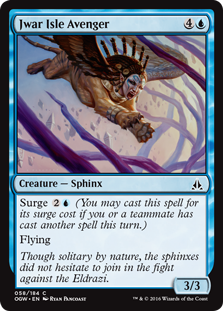 in draft—mostly, it will set up some powerful turn fives. That means you can’t go too deep on [mtg_card]Jwar Isle Avenger[/mtg_card]. [mtg_card]Expedite[/mtg_card] and [mtg_card]Slip Through Space[/mtg_card] are there to enable surge, but I think you only want to play those cards when your deck really wants them. This is probably a goodstuff deck, though it’s one where there are plenty of good blockers to defend early, and where your [mtg_card]Maw of Kozilek[/mtg_card] can join your flyers in putting a swift end to your opponent once you get set up.
in draft—mostly, it will set up some powerful turn fives. That means you can’t go too deep on [mtg_card]Jwar Isle Avenger[/mtg_card]. [mtg_card]Expedite[/mtg_card] and [mtg_card]Slip Through Space[/mtg_card] are there to enable surge, but I think you only want to play those cards when your deck really wants them. This is probably a goodstuff deck, though it’s one where there are plenty of good blockers to defend early, and where your [mtg_card]Maw of Kozilek[/mtg_card] can join your flyers in putting a swift end to your opponent once you get set up. - Black-Green: [mtg_card]Scion Summoner[/mtg_card] into [mtg_card]Eyeless Watcher[/mtg_card] into [mtg_card]Swarm Surge[/mtg_card] is a thing you can do! [mtg_card]Slaughter Drone[/mtg_card] and [mtg_card]Stalker Drone[/mtg_card] actually do a pretty good job of holding the ground or getting in for damage to set up that kill, and [mtg_card]Tajuru Beastmaster[/mtg_card] (or Warcaller, if you’re lucky) still exists. [mtg_card]Havoc Sower[/mtg_card] is a pretty great way to spend all the colorless mana green cards can find. There’s also an attrition theme suggested by [mtg_card]Baloth Null[/mtg_card], though most of the stuff that rewards you for sacrificing creatures is rare. It could be enough just to get back two good threats.
- Red-White:

A proof-of-concept for a red-white equipment draft deck.
Like red-black, I think there could be a decent aggressive Ally deck here. [mtg_card]Weapons Trainer[/mtg_card] seems like a trap; I am pretty skeptical of [mtg_card]Bone Saw[/mtg_card], though there is enough first strike, trample, and flying in red and white at common that it might play better than it looks. Typically, it’s not worth a card, and I don’t feel it’s doing anything in this archetype that can’t be attributed to the power of the red and white creatures themselves. Those [mtg_card]Boulder Salvo[/mtg_card]s would look just about as good on turn four, getting surged out by a two-drop or a combat trick.
- Green-Blue:

Green-blue gives lots of ways to accelerate your mana, lots of big creatures, and lots of ways to make colorless.
These colors look good for ramping to me, though it’s true that [mtg_card]Cultivator Drone[/mtg_card] won’t always help cast your fatties. [mtg_card]Gravity Negator[/mtg_card] is an additional payoff: if your fatty isn’t good enough on its own, taking it to the skies for a turn or two should break the game open. It could be worth paying attention to what is giving you colorless mana, versus what can ramp your green mana: [mtg_card]Plated Crusher[/mtg_card] is a nice prize. In addition, these colors probably have the best colorless deck; [mtg_card]Blinding Drone[/mtg_card] and [mtg_card]Gravity Negator[/mtg_card] are both good payoffs, and green has a lot of tools to fetch out [mtg_card]Wastes[/mtg_card].
Oath draft should be a distinctly different experience from Battle for Zendikar: there won’t be as many huge Eldrazi, creatures will be a little more clustered in terms of their powers, toughnesses, and mana costs, and synergy will matter less. In Oath, a good creature for your deck is usually just a good creature, period. That said, there’s value in knowing what your overall plan is and having a roadmap to get there: even in a small set, you’ll have choices to make between two creatures or two removal spells, and when that choice comes up, you’ll be happy you have an archetype in mind.
Let me know if I missed any archetypes you’re excited about (on Twitter @cutefuzzy_) and good luck drafting!
